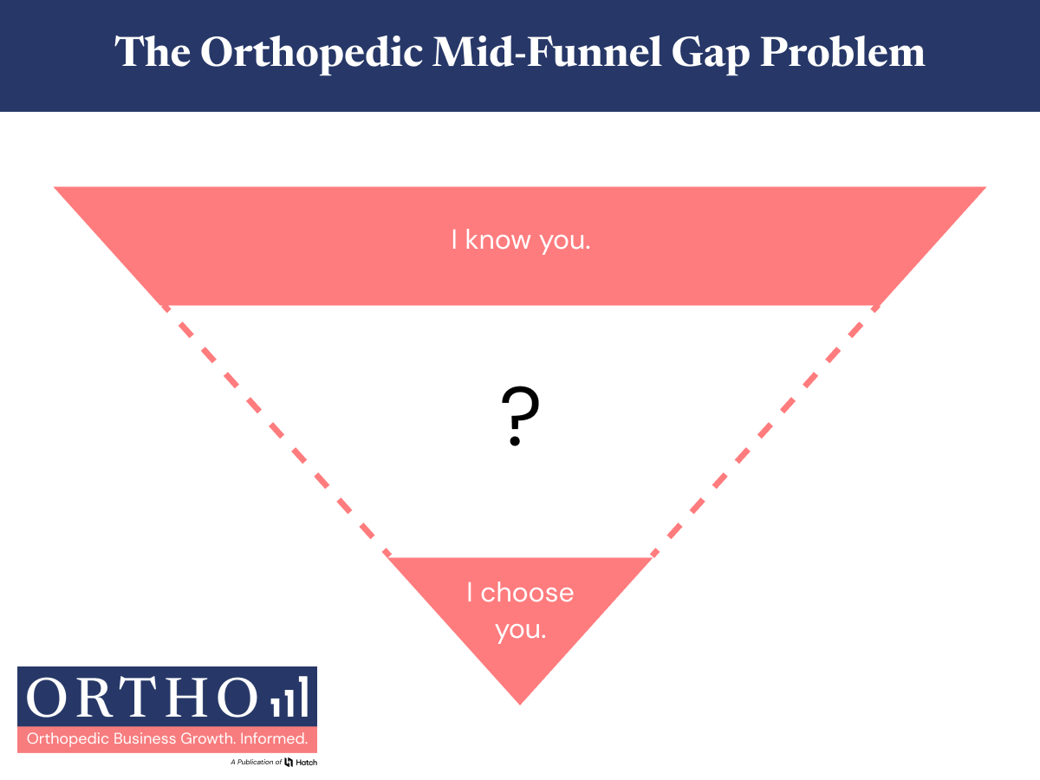
Ortho111 #14
Over 50% of the US population experiences MSK-related pain. Of that group, less than 9% have an orthopedic encounter in a given year.
What happens with the other 91%? Some treat at home, others try non-traditional remedies, and others do nothing, prolonging the pain and inevitable.
What I’ve found interesting about healthcare marketing is the focus organizations place on the 9%. I’ve sat in many hospital board meetings and witnessed them fret over the .05% increase in market share the competitor next door made last quarter.
Instead of deploying all resources to fight for the 9% of patients that will receive a service this year, I recommend investing in strategies to grow the overall pie – to engage the 91% of consumers in your market that could be buyers but right now are not.
I see most hospitals, physician practices, and other medical providers focusing their efforts in two places:
But what’s being done in the middle?
What is available for the 91% of patients who need more than awareness of your brand but are not ready to step into your urgent care or schedule an appointment with a specialist?
This is what I refer to as the Mid-Funnel Gap.

The Mid-Funnel Gap occurs when there is a disconnect to smoothly transition potential patients from mere awareness to actual decision-making and action.
Characteristics of the Mid-Funnel Gap
Creating low-commitment, high-value offers for consumers is a traditional marketing tactic across all industries. At large, healthcare lags behind.
Here are a handful of easy-to-implement ideas for you to evaluate adding to your marketing arsenal:
With all of these, collect data and communicate with these consumers over time. Whether that be personal notes, email marketing, or direct mail, committing to long-tail relationship-building will be the difference in them picking you or an alternative when the time comes.
Remember, these tactics are not intended for the 9% ready to come in. Where that may be a secondary benefit, the Mid-Funnel Offer is intended to build affinity with your market’s consumers, to be the trusted expert, and to be the one they select when they inevitably make that decision.
Forecasting
Today, many healthcare systems and practices rely on lagging volume indicators to predict next month’s volume. Most consumers are unknown until they schedule an appointment or walk into an urgent care for the first time.
By engaging consumers earlier in their journey, you’ll be better equipped to forecast your expected volume based on the leading indicators of mid-funnel engagement. Monitoring the number of online triage sessions, attendance at events, or submissions of health risk assessments can provide predictability to downstream visits.
Marketing ROI
As someone who has been responsible for marketing budgets for the last decade, I’ve had my fair share of arguments conversations with CFOs about ROI justification. Attribution can be wildly difficult, regardless of industry or product.
What’s beautiful about mid-funnel marketing is these strategies convert consumers from unknown to known, allowing you to track more easily. Where a billboard or radio ad is nearly impossible to prove ROI, showing a patient completed an HRA, spoke to an athletic trainer about their results, attended an event, and then came in for an appointment is crystal clear.
A storm is coming
I’ve heard from several orthopedic groups that 2023 was a banner year - record volumes and revenues. With the tailwinds of an aging population and demand for more orthopedic surgeons, there is a lot to be excited about. But the pessimist in me sees a storm brewing in the distance. Rising labor costs, declining physician reimbursement, private equity entrants, and new, non-traditional competitors create an uncertain future for practices wanting to stay independent.
Addressing the Mid-Funnel Gap is a low-cost, easy-to-implement strategy that increases your likelihood of engaging patients in need (before competitive alternatives do).